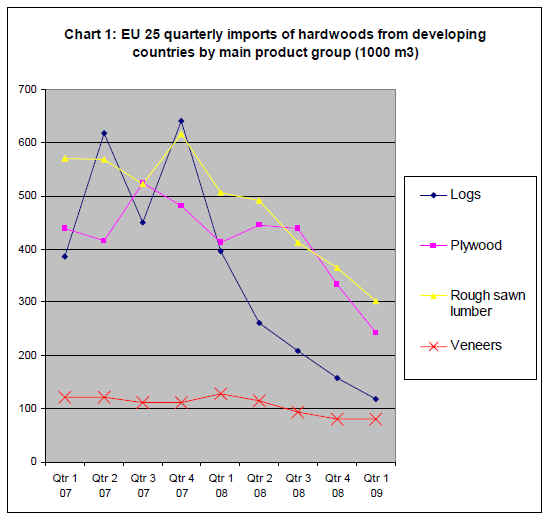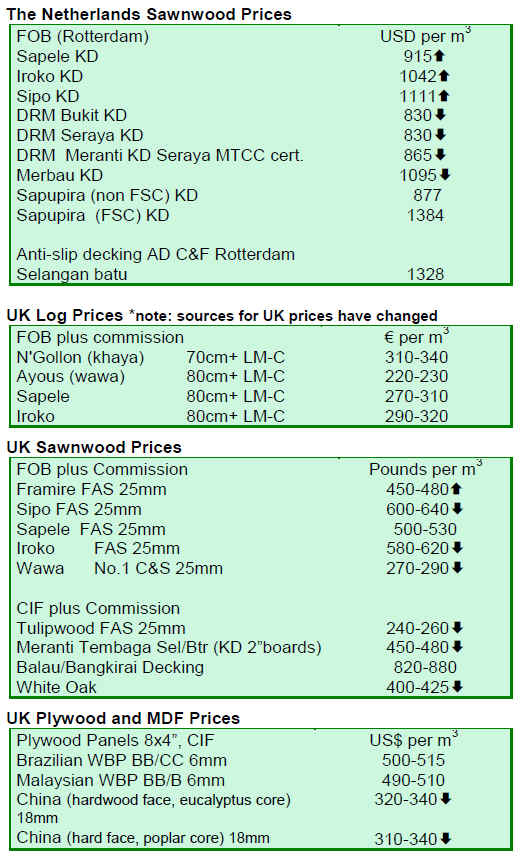|
Report
from
Europe, the UK
and
Russia
Massive drop in EU-25 imports during first quarter
The latest trade data shows that the volume of hardwood
primary wood products (logs, rough sawn lumber, veneer
and plywood) imported into the EU-25 group of countries
from developing nations was down 48% during the first
quarter of 2009 compared to the same period the previous
year. Imports during the first quarter of 2009 were also
down 20% on the fourth quarter of 2008. The figures
reinforce anecdotal reports of a collapse in forward buying
of tropical hardwood products at the end of last year as
importers responded to the credit crunch with radical steps
to cut stocks.
The extremely low level of import during the first quarter
of 2009, which follows on from a long period of declining
imports which set in at the start of 2008, also suggests that
EU stocks may now be at historically low levels. This
factor, combined with clear signs that forward supplies are
tightening, raises the prospect of supply shortfalls in the
EU later this year. A recent TTJ hardwood market report
notes that ¡®nearly all contacts reported that production
cutbacks have resulted in tight supply, which is getting
worse. It wouldn¡¯t take much of a pick-up in demand for
prices to rise and shortages to kick in¡¯. The report suggests
that the shortfalls could be almost universal with respect to
species, commenting that ¡®75-80% of the supply areas are
going to struggle to cope with any increases in demand¡¯.
But for the time being there has yet to be any significant
move by importers to replenish stocks. A widely expressed
view in the trade is that existing European landed stocks of
sapele, the dominant African joinery species, are probably
sufficient to tide the trade over the quiet summer months.
Significant forward orders are now unlikely to emerge at
least until after the European summer. Although there is
awareness of the potential for future supply shortages later
in the year, there is insufficient confidence in the future
development of European consumption to encourage
importers to make speculative purchases. Added to this is
considerable uncertainty over the future development of
the euro, dollar and pound sterling exchange rates.
Chart 1 shows the quarterly volume of logs, rough sawn
timber, veneer and plywood imported from developing
countries by the EU-25 group of countries (i.e. all EU
countries excepting new members Romania and Bulgaria)
from the start of 2007 until the first quarter of 2009. It
highlights that the dramatic decline in EU imports of
hardwood logs and rough sawn lumber from developing
countries which set in from the start of 2008 has continued
at least until the end of the first quarter of 2009. It shows
that EU imports of hardwood plywood from developing
countries stayed reasonably stable until the end of the third
quarter of 2008, but then fell dramatically in the
subsequent two quarters. Imports of hardwood veneer fell
slowly and consistently throughout the course of 2008, but
the decline flattened out in the first quarter of 2009.

Chart 2 shows trends in total imports of primary and
secondary hardwood products from developing countries
by the eight EU Member States which are the largest
importers of these commodities. It shows that the timing
of the downward trend in imports has varied between EU
Member States:
• imports have declined consistently and very
steeply into France since the start of 2008.
• imports into the Netherlands and Germany have
also declined consistently since the start of 2008
but less steeply than in France.
• a dramatic decline in imports into the UK set in
during the second half of 2008 and continued
very steeply into the first quarter of 2009.
• imports into Italy declined steeply and
consistently during the whole of 2008, but seem
to have bottomed out in the first quarter of 2009.
• the major decline in imports into Spain and
Portugal occurred during the second two quarters
of 2008 and volumes have stabilized at a low
level since then.
• imports into Belgium fell very dramatically in the
last quarter of 2008 and more slowly in the first
quarter of 2009.

Chart 3, which shows EU quarterly data by major
supplying country, suggests that the European market
downturn has been felt across the board by all suppliers,
although some have suffered more than others. EU
hardwood imports from China (mainly plywood) have
fallen very dramatically, with a particularly sharp drop
occurring in the last quarter of 2008 and the first quarter of
2009. A big decline in EU-25 hardwood imports from
Brazil occurred during the first 9 months of 2008 but
imports have subsequently stabilized at a lower level.

The fortunes of African countries supplying the EU have
varied widely over the last 18 months. Imports from
Gabon ¨C much of which are destined for France ¨C fell
away rapidly in the first nine months of 2008 and have
stabilized at a low level since then. EU imports from the
Democratic Republic of Congo rose strongly at the end of
2008 and into the first quarter of 2008, but then fell
dramatically in the second quarter of 2008 and have
remained low ever since. Imports from Cameroon have
followed a stepped pattern, declining dramatically in the
first and last quarters of 2008, stabilizing during the
intervening quarters. Imports from Côte d¡¯Ivoire and
Ghana have experienced a steady decline since the start of
2008.
Of all major tropical supply countries, only Malaysia has
maintained a reasonably strong position in the European
market over the last 18 months, significantly increasing
market share during this period. At the end of 2007,
Malaysia was only the fifth largest developing country
supplier of hardwoods to the EU market, contributing
much less than half the volume of China which then led
the field by a very large margin. However by the first
quarter of 2009, Malaysia was jostling for position with
China and Brazil to become the largest developing world
supplier of hardwoods to the EU.
The signs are that Malaysian suppliers have been the
major beneficiaries of mounting supply problems and
other competitive pressures in China and Brazil. Other
factors which might be playing a role to enhance
Malaysia¡¯s market share include: relatively rapid
turnaround times between ordering and shipment; the
willingness of Malaysian shippers to match specifications
to the letter; the strength of the euro against the US dollar
(which enhances competitiveness of US dollardenominated
Malaysian stock against competing eurodenominated
African stock); consistent marketing by the
Malaysian Timber Council; and the country¡¯s ability to
supply the EU market with competitively priced FSCcertified
combi-plywood lines and, following recent PEFC
endorsement of the Malaysian Timber Certification
System (MTCS), PEFC-certified sawn wood products.
A note on prices
Over recent months it has proved extremely difficult to
gather reliable forward price information from European
importers. Prices have tended to be quoted over a large
range reflecting a market situation where there has, in
reality, been extremely limited forward buying and heavy
reliance on existing landed stocks which, for some species,
are being sold at well below replacement price. To some
extent therefore, the prices quoted here are more an
indication of what the EU trade is willing to pay and what
may be achieved when selling from existing landed stock
rather than what would be an acceptable price to the
shipper that truly reflected the cost of production.

¡¡
|